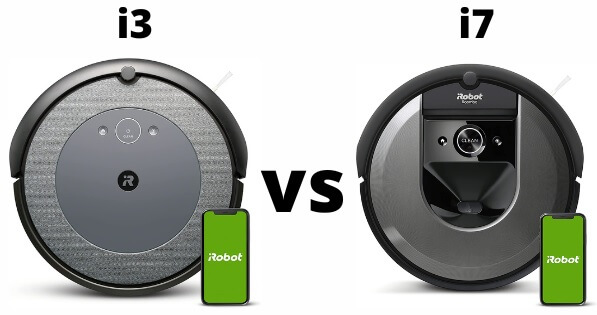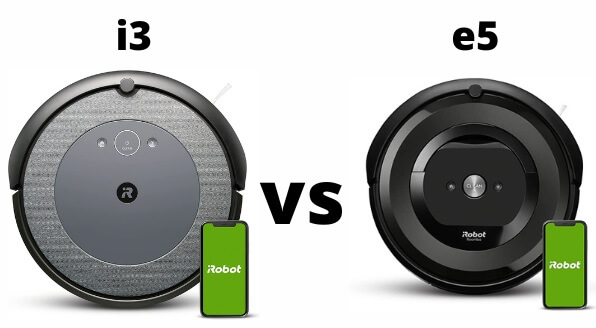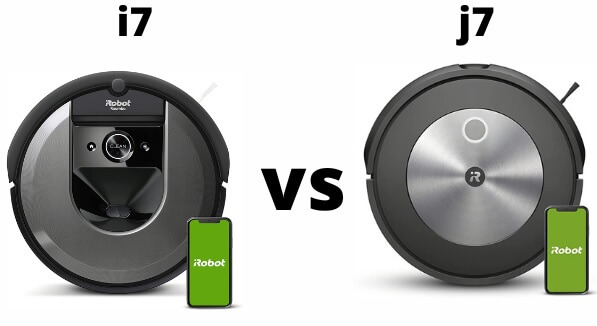In this article, we compare four different models of the iRobot Roomba vacuums.
Table of Contents
iRobot Roomba i3 vs i7
The biggest difference between the i3 and i7 is that the i7 is a full-fledged mapping robot while the i3 is not.
The i7 generates a map of the area it cleans and you can label rooms, set the robot to clean specific rooms, set keep out zones and set cleaning zones for the i7, using the iRobot companion app.
The i3 also generates a map of the area it cleans, but its mapping functionality is much more limited. You can only label rooms and set the robot to clean specific rooms.
The i3 does not give you the ability to set keep out zones or cleaning zones like the i7.
Note that room labeling and room specific cleaning was only added recently for the i3. During testing for our i3 review, the i3 didn’t have any mapping functionality at all.
Another big difference between the i3 and i7 involves how each robot navigates.
The i3 uses a gyroscope and an optical sensor on the bottom of the robot for its navigation.
The i7 uses a camera mounted to the top of the robot and navigates slightly more efficiently, completing its cleaning cycles slightly quicker than the i3.
The only other notable difference involves each robot’s edge cleaning performance.
The i7 does clean edges better than the i3 according to our testing.
The i7 pads ever so slightly closer two edges as it passes close and parallel to them, which gives it better pickup in this one area.
Otherwise both robots pick up debris equally well. Both robots performed well in our carpet stress test. Both performed well in our carpet deep clean test. And both performed well in our hard floor stress test.
they performed so similarly because they have essentially identical airflow and suction and feature an almost identical brush roll design.
Both robots were tested to have fairly low airflow and suction offset by their having two brush holes instead of one.
And the two brush rolls they have are essentially interchangeable between either robot. This brush roll design lends itself to not tangling as easily with longer hair.
And in our human hair pickup testing, both the i3 and i7 performed better than most other robot vacuums we tested.
The opposite was the case in our pet hair pickup testing. Here both the i3 and i7 had some trouble picking up the shorter pet hair used for this test.
More so than most other robot vacuums we tested.
Otherwise the i3 and i7 have identical battery life, only 80 minutes.
They both have essentially identical dust bins with a volume of 500 milliliters and the plus models of each robot come with the exact same self-empty clean base.
Both robots also have the same noise output measured at 65 decibels.
In terms of general recommendations, the i7 is the much better robot vacuum. Its full-fledged mapping ability that is being able to set keep out zones and cleaning zones makes a big difference in day to day use of the robot.
So does its better edge performance.
It is considerably more expensive though, so you do have to pay for these large advantages.
If you’re on a limited budget, the i3 does compare very favorably to the i7, outside of mapping functionality and edge performance.
iRobot Roomba e5 vs i3
The first big difference between the Roomba i3 and Roomba e5 involves mapping functionality
When we initially tested the i3 for review, it did not offer any mapping functionality, but iRobot has now via an over-the-air software update added the ability to label rooms and set the i3 to clean specific rooms using the iRobot companion app.
The e5 does not offer any mapping functionality and it will also not receive any update to add such functionality.
Another big difference between the i3 and e5 has to do with how each robot navigates.
The i3 is equipped with a gyroscope and an optical sensor on the bottom of the robot, which gives it the ability to clean neatly in rows.
The e5 doesn’t have these same components and so it cannot clean neatly in rows. Instead it paths randomly.
In our clutter room test we also see the i3 moving more carefully and more precisely around obstacles
We see the e5 bumping into obstacles much more aggressively, moving the chair frame much more than the i3 over the full duration of the test.
We do see both robots cleaning the room with similar efficiency. They both are able to get mostly complete coverage in the room in a similar time frame.
This was a very small room though, only eight feet long by eight feet wide. Over larger areas, the i3 should be able to clean more quickly than the e5 because it’s able to clean neatly in rows.
Over larger areas, the i3 also has another advantage over the e5, recharge and resume.
The i3 has the ability to clean part of a very large area, return to its base to recharge when its battery runs low and then resume cleaning where it left off.
The e5 doesn’t have this capability. It will return to its dock once its battery runs low, and if you set it to clean again, it will start back up from the beginning, which could keep it from cleaning areas far away from the dock over time.
The i3 does have one big disadvantage compared to the e5, edge debris pickup.
The i3 only picks up edge debris by moving close and parallel to it and it doesn’t do the best job picking up edge debris in this way.
The e5 on the other hand as part of its random pathing also moves parallel and close to the edge, but adds this circular movement against it, which goes a long way in improving its overall edge pickup performance and gives it better edge pickup performance than the i3.
The last difference of note between these two models involves self-emptying.
The i3 is compatible with a self-emptying dock, and the i3+ actually comes with this dock. The e5 is only available with a standard dock. It cannot self-empty.
Outside of these differences, the two robots are very similar. They have an almost identical brush compartment with almost identical brush rolls.
Both robots were also measured to have right about the same airflow and suction. Snd so they both performed very similarly in all of our debris pickup testing.
They perform similarly in our carpet stress test, our carpet deep clean test and in our hard floor stress test. Outside of edge debris pickup of course.
Both robots performed well in our human hair pickup test. Their brush rolls don’t have any bristles so they don’t tangle as easily with longer hair.
Both robots did struggle a bit in our pet hair pickup test. They both tend to push around the pet hair a bit and or get some of the hair stuck underneath instead of quickly picking it up, like most other robot vacuums we tested.
Both robots have below average battery life compared to other robot vacuums of the same type. And both have above average noise output compared to other robot vacuums of the same type.
When it comes to general recommendations, we definitely recommend the i3 over the e5.
The i3 is often for sale at close to the same price as the e5 and it is the better robot vacuum overall.
It offers room labeling and room specific cleaning, navigates more efficiently, at least in larger spaces, it features recharge and resume and it’s compatible with a self-empty docking station.
iRobot Roomba i7 vs j7
The biggest difference between the i7 and j7 is small obstacle detection and avoidance.
The j7 can detect and avoid small obstacles, like shoes and pedways, while the i7 cannot, it runs right over such obstacles.
Another big difference involves navigation in dark environments.
The j7 can navigate better than the i7 in dark environments because it’s equipped with a light underneath its camera. The i7 doesn’t have this light and therefore does not navigate as efficiently in dark environments.
Another difference between these two robots involves battery life. The j7 comes equipped with a larger battery that gives it 100 minutes of battery life, while the i7 comes equipped with a smaller battery that gives it only 80 minutes of battery life.
Both robots are compatible with self-empty docking stations, though the self-empty dock compatible with the j7 has been redesigned to have a lower, wider profile, while the self-empty dock compatible with the i7 is taller and narrower in its design.
The robots themselves feature a very similar design and so performed very similarly in our real world performance testing.
They both picked up surface level debris very well in our carpet stress test and embedded it pretty well in our carpet deep clean test.
They both also picked up surface level debris well in our hard floor stress test with excellent edge performance. both robots also performed very similarly in both our human hair pickup testing and in our pet hair pickup testing.
You use the exact same app with very similar functionality to control both robots.
Both robots are also full-fledged mapping robots, so you can set no-go zones and cleaning zones for either robot.
Bin size is identical for both robots. So is noise output and each robot’s overall dimensions.
When it comes to general recommendations, which model we recommend over the other really comes down to price.
Since the i7 is now an older model, you can often find it on sale significantly cheaper than the j7, and if you’re a more budget oriented consumer, it can be a great option over the j7.
Outside of price and value, the j7 is definitely a better robot vacuum than the i7. It’s able to detect and avoid small obstacles, navigate better in dark environments and has better battery life.
If price is not as much of a concern, we do recommend the j7 over the i7.



